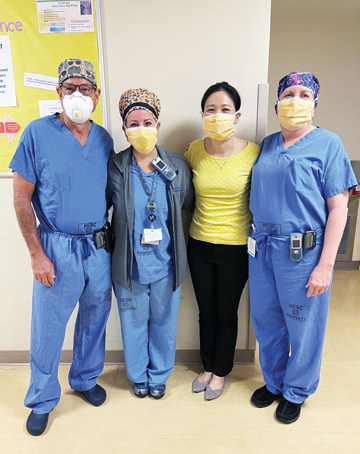Surgical leaders get creative to hold on to their top staff.
 COMMON PURPOSE ASCs that maintain positive workplace cultures based on respect and inclusiveness are more likely to retain valuable employees. | Lehigh Valley Health Network
COMMON PURPOSE ASCs that maintain positive workplace cultures based on respect and inclusiveness are more likely to retain valuable employees. | Lehigh Valley Health Network
Retention of staff is an ongoing, intensifying problem for many outpatient surgery facilities. Recently, some administrators shared their ideas with Outpatient Surgery Magazine on how to maintain full, capable, productive staffs while competing with much larger and better-financed health systems for talent.
Correct your salary scale. One huge problem is longtime staff becoming resentful of new hires who receive bonuses and sometimes even higher salaries than they have. These professionals feel their earning prospects are being penalized due to their loyalty. To address these types of disparities, Administrator Norma Bacon at New England Surgery Center in Beverly, Mass., changed her ASC’s pay scale to be based on number of years as a nurse.
Per diem instead of salaried. Sani Eye Surgery Center in Templeton, Calif., has a solid team of nurses who have worked at the center long-term as well-paid per diem staff. “We pay an average of 20% more than other ASCs in the area,” says Administrator Dianna Reed, BA.
Better work/life balance. ASCs have long sold new hires on the more predictable nature of employment at a same-day surgery center, such as Monday through Friday regular working hours, weekends off and no call. However, staff are now asking for increased flexibility. “We have utilized more flexible schedules,” says Linda Nelson, MSN, RN-BC, CASC, administrator at North Pinellas Surgery Center in Dunedin, Fla. “Several of our nurses work 32 hours over four days, for example. It has helped with work/life balance, which aids in retention.”
Keep it stimulating.“I cross-train whoever I can so they keep learning and don’t get bored in their current roles,” says Cindy Novak, RN, BS, administrator at San Luis Obispo (Calif.) Surgery Center.
Workplace culture. The staff at Chugay Cosmetic Surgery in Long Beach, Calif., has been in place for more than a decade. How do they do it? “We have a team that works and has been treated as a family,” says Administrator Maria E. Pescasio, BS, who adds that the family vibe includes profit-sharing and bonuses.
“We have great people and a really good generational mix,” says Barb Draves, LPN, CASC, administrator at The Surgery Center in Middleburg Heights, Ohio. “Maternity leaves on the young ones and joint replacements on the older ones always create havoc for scheduling, but they all know that it all balances out in the end.”
Shane Ricks, RN, BSN, MHS, administrator at Millennium Surgery Center in Meridian, Idaho, kept his staff intact throughout the pandemic. “We have not had any significant issues due to staffing for the past two years,” he says. “I believe it is due to our excellent work culture.”
Stephen Gatesman, RN, clinical director/administrator at Executive Park Surgery Center in Fort Smith, Ark., shares a similar report. “We have been able to retain staff by maintaining a positive workplace culture.” Echoes Laurie Bailey, regional administrator at New Braunfels (Texas) Surgery Center, “We have excellent staffing and retention at my main location because of employee satisfaction and culture.”
Syracuse (N.Y.) Surgery Center is currently fully staffed with per diems for coverage. Additionally, says Andrea Sanders, RN, BSN, administrator/clinical director, “We gave across-the-board cost of living wages along with annual merit-based raises for all staff.” However, she says workplace culture ultimately keeps providers at the facility. “We have really nurtured a culture that is based in understanding, kindness and comradery,” she says.
The common thread at all of these facilities is leadership that not only appreciates the efforts of their employees, but also takes the time to understand what individuals are looking for in their career, and strives to deliver those benefits.
.svg?sfvrsn=be606e78_3)



.svg?sfvrsn=56b2f850_5)